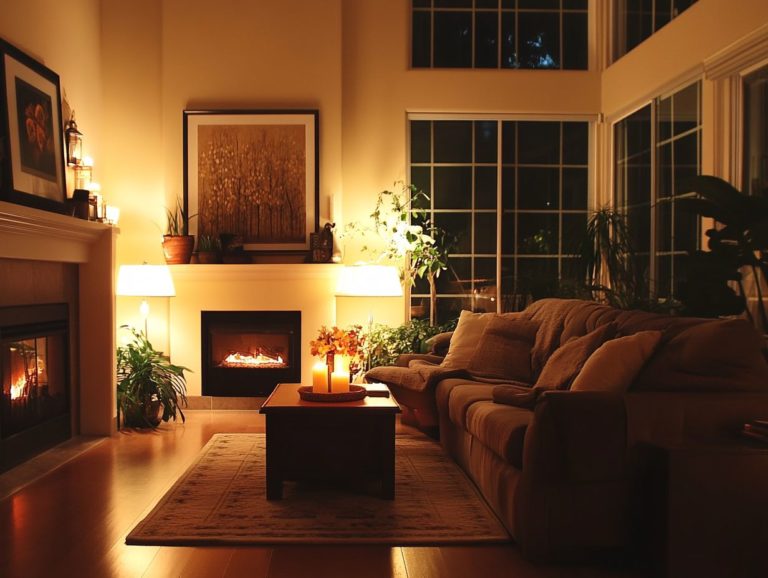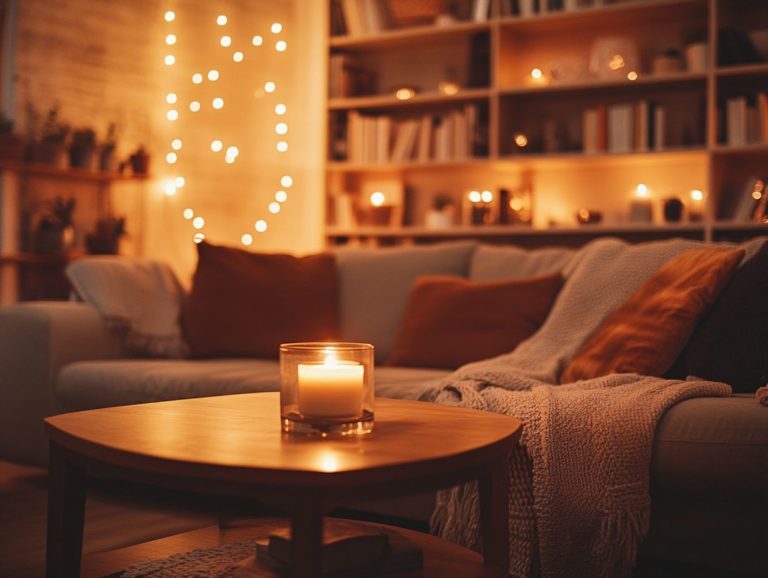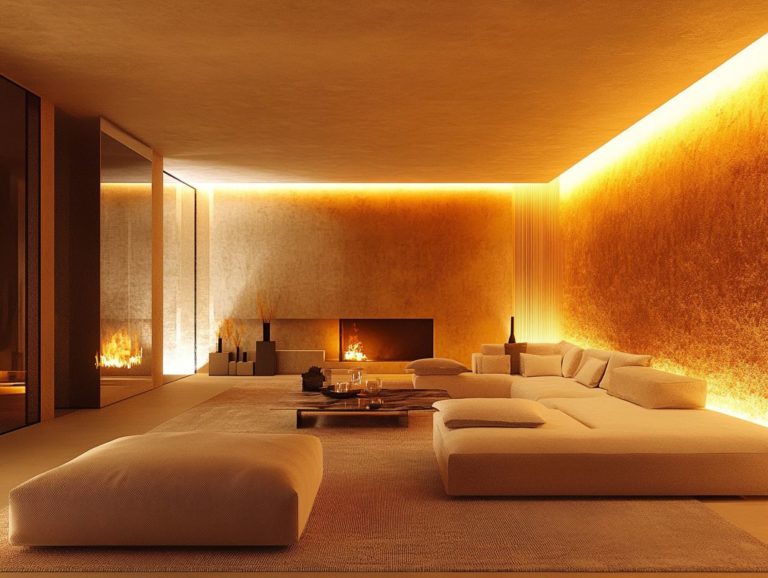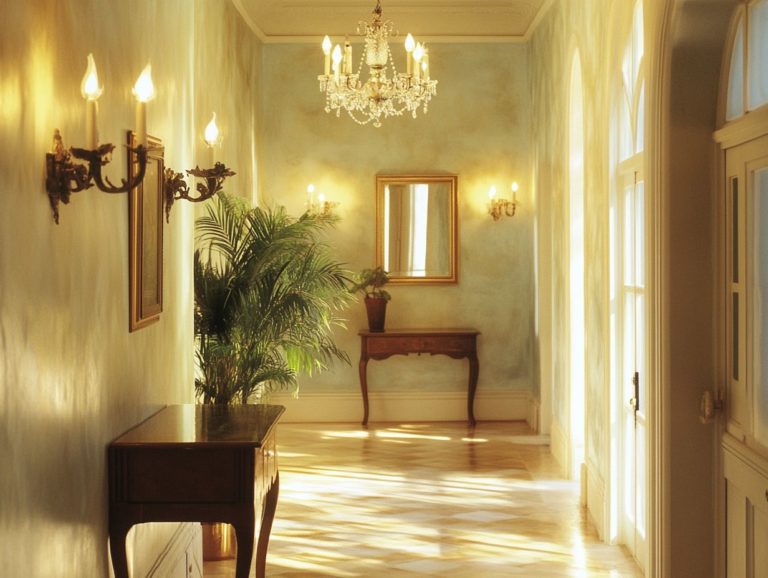“Understanding Lighting for Different Activities”
Lighting significantly enhances your daily experiences, impacting everything from productivity to mood.
This article delves into the various types of lighting ambient, task, and accent and highlights their importance for different activities. You ll discover how to choose the right lighting to meet your needs, whether you’re reading, cooking, or working from home.
Furthermore, you ll find practical tips for optimizing your space with effective lighting strategies. Brighten your space and feel the energy shift!
Contents
- Key Takeaways:
- Types of Lighting for Different Activities
- Choosing the Right Lighting for Your Activities
- Lighting for Specific Activities
- Tips for Properly Lighting Your Space
- Frequently Asked Questions
- What is “Understanding Lighting for Different Activities”?
- Why is proper lighting important for different activities?
- What factors should I consider when choosing lighting for various activities?
- How can lighting affect energy levels and productivity?
- What lighting works best for different activities?
- Are there health concerns related to improper lighting for different activities?
Key Takeaways:
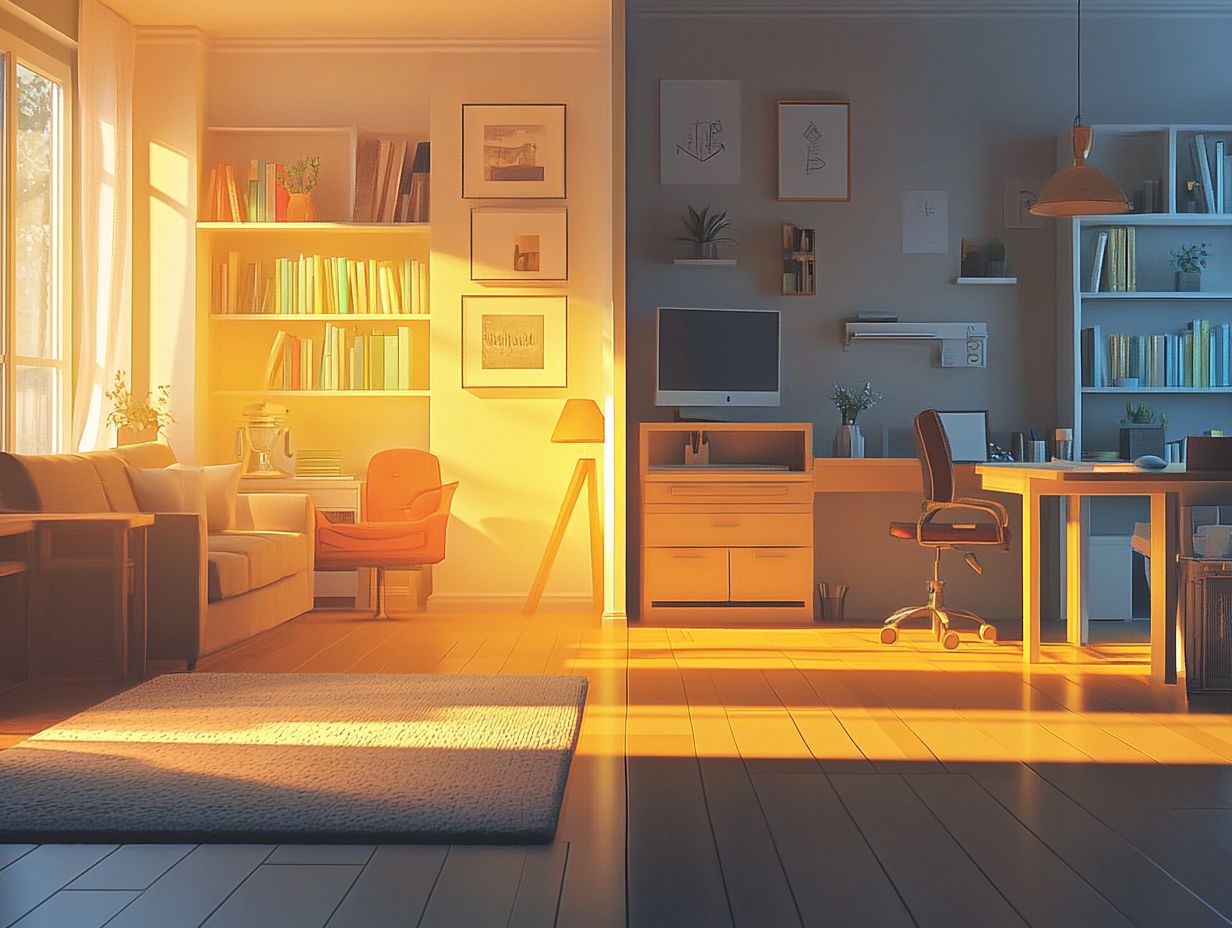
- Understand the importance of lighting for different activities and how it can affect your mood and productivity.
- Knowing the different types of lighting ambient, task, and accent can help you create the perfect atmosphere for each activity.
- Think about brightness, where you place lights, and how natural light fits in. Layer your light sources for the best results!
Why Lighting is Important for Different Activities
Lighting plays a pivotal role in your daily activities, affecting how your spaces look and feel while significantly impacting your productivity, mood, and energy efficiency. When planned properly, lighting can enhance how you engage in various activities, whether you’re diving into a good book at home, whipping up a delicious meal, or crafting an inviting atmosphere for entertaining guests.
It’s essential to consider the different types of lighting techniques ambient, task, and accent lighting since each serves a distinct purpose and can elevate your overall experience.
For example, task lighting is crucial in your workspace, helping you concentrate and reducing eye strain during intricate tasks. Meanwhile, ambient lighting can create a soothing ambiance in relaxation zones, such as your living room or bedroom, fostering a sense of calm.
Energy-efficient lighting options like LED bulbs not only trim your electricity bills but also minimize your environmental footprint, aligning perfectly with sustainable living practices. Ultimately, your choice of illumination impacts your daily routines, enhancing efficiency while enriching the comfort and atmosphere of your home.
Types of Lighting for Different Activities
Understanding the various types of lighting available is crucial for crafting a well-lit environment tailored to your specific activities. From ambient lighting that casts a gentle glow to task lighting designed for functionality and precision, each option serves a unique purpose.
As a homeowner, you can select from a diverse array of lighting fixtures that cater to your needs, ensuring that the perfect atmosphere is achieved for every occasion be it reading, cooking, or entertaining guests.
Ambient Lighting
Ambient lighting serves as the essential foundation of illumination in any space, crafting a comfortable and inviting atmosphere while elevating the overall interior design. This type of lighting often mirrors the gentle glow of natural light, making it vital for anyone looking to brighten their living spaces and cultivate a serene environment.
By employing a diverse array of fixtures think ceiling-mounted lights, wall sconces, and floor lamps you can effortlessly achieve that soft, diffused glow. Strategically placing these fixtures allows you to highlight architectural features, artwork, or treasured decorations, enhancing the aesthetic charm of your surroundings.
The warmth of ambient lighting works wonders in reducing stress, fostering a sense of relaxation and comfort. When layered with task and accent lighting, these ambient solutions create a well-balanced and functional environment, proving integral in any thoughtfully curated interior design scheme.
Start refreshing your space today with the right lighting choices!
Task Lighting
Task lighting is your secret weapon for illuminating those key areas where focused attention is a must. Think reading, cooking, or working from home. This lighting choice directly impacts productivity and efficiency.
By employing the right lighting techniques, you can ensure that each workspace is not just well-lit but also functional, crafting an environment that promotes effective task completion.
This style of lighting serves a unique purpose, distinguishing itself from ambient lighting, which merely casts a general glow over an entire space. Effective task lighting is crucial in reducing eye strain and boosting concentration. It’s essential for study areas, kitchens, and offices.
To implement effective task lighting, consider these options:
- Adjustable desk lamps for your workspace.
- Under-cabinet lights in your kitchen.
- Wall-mounted fixtures in your cozy reading nook.
Choosing lights that allow for adjustable brightness and the warmth or coolness of light can elevate your experience even further. This gives you the flexibility to tailor the ambiance to your specific needs and preferences, amplifying your focus and enhancing your overall comfort.
Accent Lighting
Accent lighting is your secret weapon for highlighting specific areas or architectural features in your space. It adds visual interest and elevates the overall lighting design, making it essential for anyone aiming to create a stunning ambiance.
This type of lighting draws the eye to artwork, plants, or unique architectural elements, enriching the aesthetic appeal of every room.
Beyond its decorative charm, accent lighting serves practical purposes as well. It enhances visibility in dark corners and illuminates passageways, creating a safe and inviting environment.
Consider various applications like:
- Wall sconces that frame your artwork beautifully.
- Track lighting that allows for adjustable angles to spotlight your favorite features.
- Recessed fixtures that offer a sleek, unobtrusive look.
By incorporating dimmable LED fixtures or stylish pendant lights, you can effortlessly adjust the mood, transforming your spaces for relaxation or entertaining.
Mastering the art of accent lighting can dramatically elevate your home s interior design, providing both functionality and beauty.
Choosing the Right Lighting for Your Activities
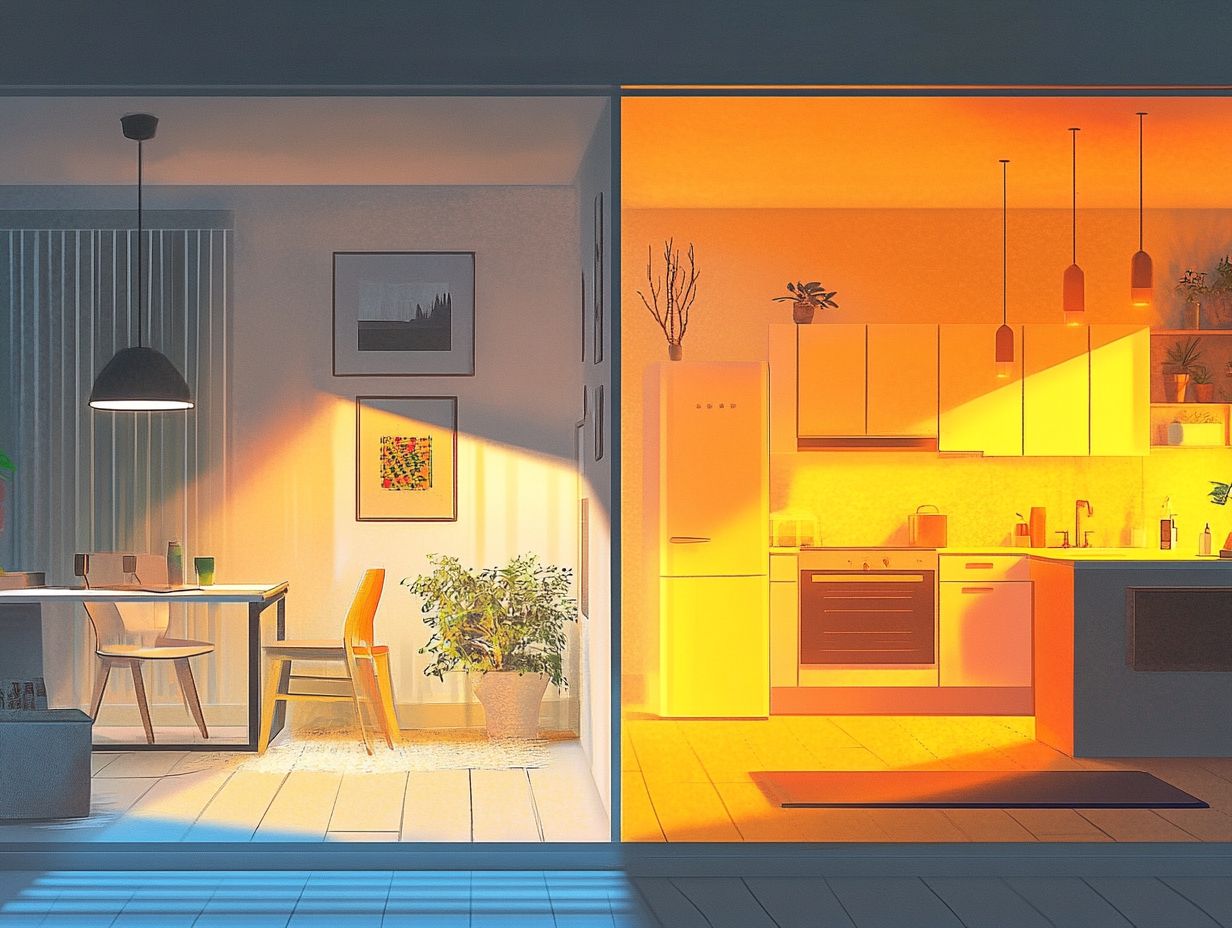
Selecting the right lighting for your activities requires thoughtful consideration of several factors that profoundly influence both functionality and aesthetics. Take a moment to think about how your lighting design aligns perfectly with the specific needs of your space.
Assess your activities, evaluate your environment, and consider energy efficiency. Explore the various types of lighting fixtures available and reflect on how each option can enhance your overall design.
By doing so, you ll create a harmonious atmosphere that elevates both form and function.
Factors to Consider
When you re choosing the perfect lighting for various activities, several key factors come into play. Consider lighting techniques, energy efficiency, and color theory to create the right ambiance that boosts productivity.
Understanding how different colors and intensities of light impact mood can help you select the ideal lighting solutions for your spaces. The importance of color temperature is paramount; warm hues create a relaxing and comfortable atmosphere, making them perfect for living areas. In contrast, cooler tones can enhance focus and alertness, which are vital for workspaces or study areas.
Opting for energy-efficient lighting options, like LED bulbs, not only trims your utility bills but also supports environmental sustainability.
Using strategic lighting techniques, such as layering (using different types of lights together) or task-focused illumination, can significantly enhance your daily activities. This achieves that perfect balance between aesthetic appeal and functional needs.
So, explore the world of lighting today and discover how to create your perfect space!
Lighting for Specific Activities
Different activities need custom lighting solutions to enhance performance. Tailoring your lighting design for each scenario is essential.
Whether you need task lighting for your reading nook or ambient lighting for relaxation, understanding the unique needs of each activity helps you create the perfect atmosphere at home.
Reading and Studying
Task lighting is crucial for reading and studying. It provides focused light that boosts productivity and reduces eye strain.
A well-lit workspace enhances concentration and improves information retention. Choosing the right lamp is key.
Opt for adjustable desk lamps to direct light where you need it, ensuring clear visibility while minimizing shadows.
The color of the light matters too. Warm tones create a cozy vibe, while cooler lights are more energizing, helping you stay alert.
Position your light source to the side of your dominant hand. This reduces glare and distractions.
Dimmable options allow you to customize lighting for different times of the day, ensuring optimal conditions for reading and studying.
Cooking and Meal Preparation
In the kitchen, good task lighting is essential for cooking and meal preparation. Bright spaces enhance safety and efficiency while you work.
Strategically place overhead fixtures like recessed lights or pendant lamps above key areas like countertops and stovetops.
Adding under-cabinet lighting brightens dark corners and minimizes shadows while you chop or measure ingredients.
If you enjoy crafting intricate recipes, adjustable lighting offers versatility. Switch between bright light for detailed tasks and soft light for a relaxed cooking atmosphere.
Choosing energy-efficient LED fixtures cuts down on electricity costs and improves your kitchen’s functionality.
Relaxing and Entertainment
Creating a relaxing environment starts with the right ambient lighting. This sets the mood for leisure time and entertaining guests comfortably.
By selecting light fixtures like floor lamps or string lights carefully, you can craft a compelling ambiance for any occasion.
Dimmers provide flexibility, allowing your space to transition from a calm nook for reading to a lively backdrop for gatherings.
Warm hues envelop you in calm, while cooler tones spark energy. Finding the right balance between relaxation and entertainment is essential.
Layering your lighting with task, accent, and ambient sources creates a dynamic atmosphere. Whether seeking a personal retreat or a social space, your surroundings will always shine.
Working from Home
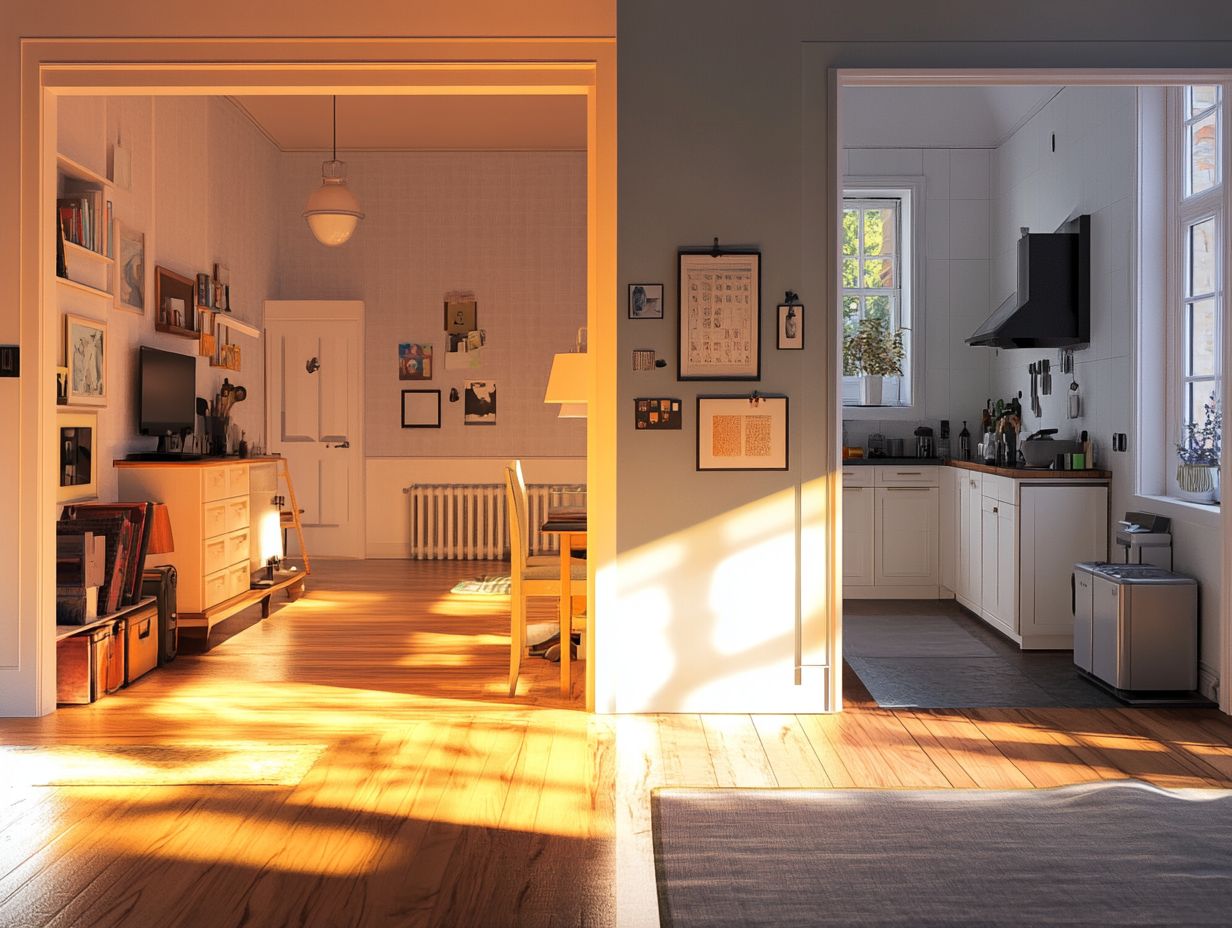
Good lighting at home is key to boosting your productivity and focus. It directly impacts how well you perform your tasks.
To create a well-balanced and functional home office environment, combine task lighting with ambient lighting. Position desk lamps with adjustable brightness near your workstation to illuminate specific tasks without causing glare on your screens.
Maximize daylight exposure by placing your desk near a window, fostering a vibrant work atmosphere. Incorporating floor lamps and overhead fixtures can enhance your layout, establishing overall light consistency. Choosing warm LED bulbs promotes a comfortable ambiance, reducing eye strain and fatigue during long work hours.
These lighting strategies not only elevate your workspace aesthetics but also contribute significantly to sustained concentration and efficiency.
Tips for Properly Lighting Your Space
Properly lighting your space requires a thoughtful approach that balances placement, brightness levels, and the effective use of natural light. Transform your environment into a harmonious and functional haven by layering different light sources for each area to be illuminated according to its purpose and ambiance.
This attention to detail elevates the overall design and enriches your living experience.
Placement and Brightness
The strategic placement and appropriate brightness of lighting fixtures are crucial for achieving the desired atmosphere in your space. Whether you’re aiming for soft lighting that envelops the room or focused lighting that illuminates work areas, assessing your needs carefully is essential for optimizing both functionality and comfort.
Understanding the dynamics of different lighting types helps create inviting spaces. For example, lights installed into the ceiling offer subtle yet effective ambient illumination, while pendant lights serve as striking focal points over dining areas or kitchen islands.
Layering light sources like combining floor lamps with wall sconces not only enhances aesthetic appeal but also adds versatility to your design. Don’t overlook the color temperature of bulbs; warmer tones can create a cozy atmosphere, while cooler tones invigorate the space. Balancing these elements leads to a harmonious and practical design that elevates your home.
Using Natural Light
Natural light not only saves energy but also lifts your spirits. Make the most of your windows and reflective surfaces to create a bright and inviting atmosphere throughout the day.
This thoughtful approach can involve strategies such as opting for larger windows, installing skylights, or placing mirrors to bounce light around the room. Choosing lighter paint colors can amplify sunlight effects, making cozy spaces feel more open and airy.
The benefits extend beyond aesthetics; increased natural light can significantly reduce your energy bills by lessening your dependence on artificial lighting. A well-lit space brightens your home, uplifts your mood, and boosts productivity transforming your living environment into a vibrant and sustainable haven.
Layering Light Sources
Ready to transform your space? Layering light sources can make a huge difference! This technique is your secret weapon for creating a well-lit and versatile area. By combining general, work, and decorative lighting, you add depth and functionality to any room. Imagine enhancing your interiors with multiple light sources, allowing you to effortlessly adjust the atmosphere based on your activities and moods.
This approach boosts visual appeal and makes your space feel more inviting. To effectively implement this strategy, start by evaluating the size and purpose of the room. For example, in a living room, consider installing a central chandelier for general lighting. You can place floor lamps next to seating areas to provide work lighting.
Wall sconces can serve as lovely decorative lights, drawing attention to artwork or architectural features. The key is to layer different types of lighting at varying heights and intensities, ensuring both functionality and aesthetic pleasure. Don t miss out on the versatility of dimmers they allow you to adapt the lighting to your specific needs throughout the day.
Frequently Asked Questions
What is “Understanding Lighting for Different Activities”?

Understanding Lighting for Different Activities refers to knowing how lighting can enhance various tasks like working, studying, relaxing, and socializing.
Why is proper lighting important for different activities?
Proper lighting greatly impacts productivity, mood, and overall well-being. It can also help prevent eye strain, headaches, and other health issues.
What factors should I consider when choosing lighting for various activities?
- Type of activity
- Specific tasks involved
- Natural lighting available
- Color temperature and brightness of the light
- Placement of the light source
How can lighting affect energy levels and productivity?
The color temperature and brightness of lighting can influence our circadian rhythm and melatonin levels. Bright, cool-toned lighting increases alertness and focus, while warm, dim lighting promotes relaxation and sleepiness.
What lighting works best for different activities?
- For studying and working: Bright, cool-toned lighting (like LED or fluorescent bulbs)
- For relaxing and socializing: Warm, dim lighting (like incandescent bulbs or candles)
Yes, improper lighting can lead to eye strain, headaches, fatigue, and disrupted sleep patterns. It can also worsen existing conditions such as migraines, depression, and seasonal affective disorder (SAD).


